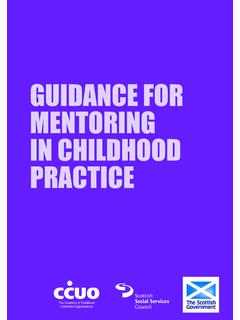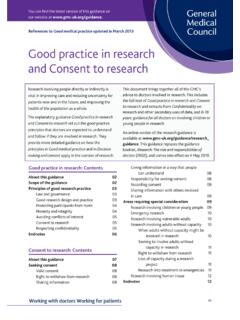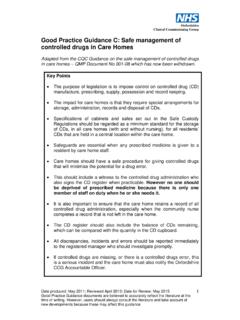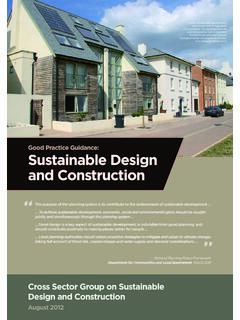Transcription of Good practice guidance and expectations for growth
1 Multi-academy trusts good practice guidance and expectations for growth December 2016 Contents Summary 4 Expiry or review date 4 Who is this publication for? 4 Main points 4 Foreword 5 Growing the number of academies with care 8 The benefits of academies and multi academy trusts (MATs) 8 Learning from good practice 9 The Regional School Commissioner (RSC) role in approving MATs and standalone academies 9 Single academy trusts 12 Role of the local authority (LA) 13 Role of the diocese 15 Governance 19 The MAT board 20 Delegation 21 Local Community Engagement 22 Geography 22 Examples on governance 23 What will RSCs look for?
2 26 Geography 27 Supporting school improvement 28 Staff workload 30 Examples of different ways of supporting school improvement 30 What will RSCs look for? 36 People and leadership 37 Examples of developing people and leaders 38 What will RSCs look for? 44 Financial Sustainability 45 Examples of identifying efficiency savings 47 What will RSCs look for? 48 2 Risk Management 50 Due diligence 51 Examples of risk management 52 What will RSCs look for? 52 Further Reading 54 Overarching 54 On SEND requirements 54 On supporting school improvement 54 On governance 55 On financial sustainability 55 Acknowledgements 55 3 Summary This publication provides non-statutory guidance from the Department for Education.
3 It fulfils the Government s commitment to publish design principles for academy trusts, including those establishing new trusts and existing trusts planning to grow. Expiry or review date This guidance will be reviewed on an ongoing basis. Who is this publication for? This guide is for all those with an interest in emerging good practice in the academy system. It will be particularly relevant for new academy trusts and maintained schools considering converting to become an academy, as well as existing trusts planning to grow.
4 Main points This document provides a framework which helps trusts at all stages of their development learn from other trusts. It sets out what we know about the characteristics of successful academy trusts, and the barriers that they will need to overcome in order to secure their ongoing success. This documents also explains what Regional School Commissioners (RSCs) will look for when assessing the capacity of MATs at each stage of their development. This document will be updated to reflect emerging good practice as we continue to learn from the academies programme.
5 4 Foreword Multi Academy Trusts (MATs) have been created by many of our best leaders, teachers and governors to improve and sustain standards in our schools. We know that the composition of MATs varies in different locations, and there is no one right model. There are great examples of primary only or secondary only trusts, but also examples of trusts with different types and phases of schools. In recent years, that has included the important contribution of the special school and alternative provision sectors too. Whilst there is no single way to create and lead a MAT, our design principles are intended to share some of the best practice we have seen and talk about the types of strategic planning and thinking that underpin it.
6 There is room and scope for MATs to develop the model that delivers the ambition of the board and executive leadership team, but it is clear that there are at least three core elements that the strongest trusts exhibit. First, a board that contains a wide range of professional experiences that can deliver the dual responsibility of building strategy to deliver great outcomes for children alongside the culture of accountability that is necessary across the organisation. Second, the appointment of an executive leader, typically an executive head or chief executive officer, who is held to account for standards across the schools.
7 Third, the creation and execution of a school improvement strategy that develops and improves the workforce, builds succession and enables the strongest teachers and leaders to influence outcomes for more children. The aspect of MAT performance that stands out in many cases, however, is the way that the best leaders, teachers and support staff are deployed to ensure that as many children as possible benefit from their skills and expertise. In some cases, this means teaching specific children or taking leadership responsibility for a subject team or initiative or through coaching and mentoring making sure that teachers and leaders who need to improve quickly are supported to do so.
8 I believe that consistently high quality leadership has contributed towards almost million more children being in good or outstanding schools today than there were in 2010. In spite of this, we know there are still performance gaps and inequalities of opportunity that exist. This is not the fault of the children in our schools. I believe that the MAT model gives us the best opportunity to close the gaps between the best and weakest performing schools in the system. Working closely with system leaders in the MAT, in partnership with those working in teaching school alliances and beyond, we can demonstrate that the most effective practice in any community can be shared so that new and better practice is introduced into the schools we want to improve quickly.
9 There must be no barrier getting in the way of ensuring that more children benefit from the practice of the very best and we have to be strategic in making sure that this model benefits every type of school 5 and every pupil who attends a primary, secondary, special and alternative provision school, whether it is an academy or a maintained school. This guidance is intended to support and encourage those trustees and leaders seeking to start a new MAT, as well as those who have a strategic plan to grow the number of schools they are accountable for in the coming years.
10 In simple terms, this is how we intend to build the culture and ethos for this to happen. We want to encourage, support and challenge the best leaders to take responsibility for more schools and to bring their expertise in school improvement to benefit more children. We want to enable the best practitioners to take advantage of autonomy so that they make the right decisions for the right children at the right time. Giving leaders and teachers the freedom to implement and replicate what works is a key driver for the MAT growth model.
















